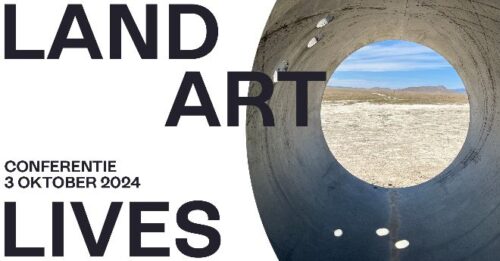Event
3.10.2024: Kunstmuseum M. & Land Art Flevoland, Agora, Lelystad, NL
Why is land art particularly relevant today? What are its new manifestations? How do we deal with these often impermanent works of art? And how does land art shed light on the urgent ecological and social issues of today?
Through the Land Art Lives program, Kunstmuseum M. and Land Art Flevoland will jointly investigate these questions at an international conference scheduled for October 3, 2024, in Lelystad.
What is Land Art?
Land art is an idea, impulse, or movement that utilizes the landscape as a place for artistic creation. Art that is all about the landscape, that lets one experience it, experiment with it and reflect on it.
The early era of land art was closely associated with the anti-institutional ethos of the 1970s, as well as other art forms stemming from it, including performance, minimalism, conceptual art, and new media. Since then, the institutions that artists opposed at the time have embraced land art. The genre has evolved into a form of commissioned art, and its ideas have evolved accordingly. Meanwhile, a history, a canon, and a vibrant, multifaceted, and developing practice characterise the field.
Land art has been and continues to be created all over the world, from Russia and Japan to Brazil, America, and Europe. This art form is particularly associated with large-scale, monumental works of art situated in the vast American desert. It is clear that this image needs to be adjusted.
International Conference
On October 3, 2024, the supporting program of Land Art Lives will come together during an international conference in the Agora Theater in Lelystad. We will start the day with several international speakers. In the afternoon, parallel working sessions on the future of land art will take place. The day will be moderated by Meta Knol. In addition to the program, there is plenty of opportunity to meet and delve further into reading and archival material.
Speakers
Humberto Moro of the Dia Art Foundation (United States) will give a lecture on the ways Dia manages iconic land artworks in America and how they deal with current developments there. Afterwards, Anja Novak of the University of Amsterdam will discuss with him the Dia Art approach in the context of Flevoland. Britta Peters of Urbane Künste Ruhr (Germany) has years of experience at Skulptur Projekte Münster and talks about her programmatic approach in the Ruhr area. Lisa Le Feuvre of Holt/Smithson Foundation (United States) will join her in conversation after the event.
Afternoon sessions
Following this inspiring input, participants will engage in afternoon discussions. Various topics and questions will be discussed in a number of parallel sessions. What is the specific dynamic between land art and the public, and is there, in response to the major spatial task facing the Netherlands, reason for new land art? Three special guests will participate in each session, including Marjolijn Dijkman (visual artist and initiator of Enough Room for Space), Orlando Maaike Gouwenberg (Sonsbeek Foundation), Benno Tempel (Museum Kröller Müller), Simone Vermaat (RCE), Mieke Conijn (IJsselbiennale), Lydia Beerkens (SRAL) and many others.
The program team consists of the curators Anne Reenders (Kunstmuseum M.) and Martine van Kampen (Land Art Flevoland), Lot Meijers (production), Anne van de Dool (texts) and Michel Langendijk (communications).

